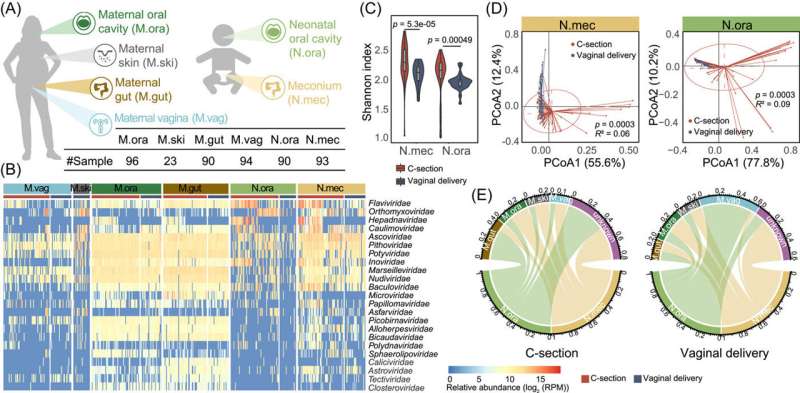Sample collection and virome comparison between C-section and vaginally delivered neonates and their mothers. (A) Samples were collected from six body sites, including oral (M.ora), intestinal (M.gut), vaginal (M.vag) and skin (M.ski) of mothers, and oral (N.ora, oral contents collected within seconds after birth) and intestinal (N.mec, meconium, i.e., the first excretion after birth) of newborns. The number of each sample type is listed in the table. (B) Relative abundance of viruses in each body site is profiled at the family level. The red and blue bars represent samples of subjects delivered with C-section and vaginal mode, respectively. The virus families with the largest intergroup variance (the intergroup variance of abundance is greater than the overall median variance) are shown. Since no skin samples of C-section mothers were collected, only the M.ski of vaginal delivery is used here. (C) Alpha diversities of viruses in N.mec (left) and N.ora (right) were calculated at the family level and are colored by delivery modes. Violins show median (black horizontal line), quartiles (edge of boxes), and kernel density estimation (violin) for each distribution. (D) Principal co-ordinates analysis (PCoA) of virome profiles in N.mec (left) and N.ora (right) was performed at the family level. (E) Viral source tracking from mothers to neonates delivered by C-section (left) and vagina (right), respectively. The proportion of shared viruses between generations was measured at the species level. Credit: mLife (2022). DOI: 10.1002/mlf2.12034
Both the gut microbiome and virome of early life have always drawn research attention because they are strongly associated with the health status of an individual in the future. The gut virome, consisting of phages and eukaryotic viruses, directly or indirectly affects infant and child health. As the dominant component in gut virome, phages shape the microbiota in early life by preying on bacteria.
A cumulative effect of enterovirus and gluten intake on the risk of celiac disease autoimmunity in infants highlights the significance of viral exposure in early life on the health of children. "Pathogenic viruses may be transmitted to the offspring in an earlier period, raising the possibility that women whose vaginas are inhabited by such viruses may have had their babies infected as early as the time of delivery," said Dr. Jinfeng Wang, who is the first author of this study published in mLife.
Dr. Zhao's team recruited 99 mother–newborn pairs—32 vaginal delivery and 67 cesarean‐section (C‐section)—and collected 486 samples from six body sites, including saliva, stool, vagina, and skin of mothers, and oral contents and the first excretion (meconium) of newborns. They used metagenomic sequencing to obtain a total of 3.85 Tb meta-genomic sequencing data to identify viruses.
They identified eukaryotic viruses and phages from both sequencing reads and metagenome assemblies, analyzed the maternal-infant virome and compared the transmission events of viruses from mothers to offspring with different delivery modes.
They found that vaginally delivered newborns seconds after birth had a more similar oral virome and more viruses of vaginal origin than C‐section newborns (56.9% vs. 5.8%). Dr. Zhao said, "Neonates are exposed to vaginal viruses as they pass through the reproductive tract, and viruses of vaginal origin may threaten their health."
This study challenges the conventional notion that vaginal delivery is definitely better than cesarean delivery through in-depth analysis of virome data from a large mother-infant paired population. A recommendable procedure for screening the vaginal virome before delivery may be needed to avoid the risk of intergenerational transmission of pathogenic viruses to the offspring's GI tract.
More information: Jinfeng Wang et al, Maternal and neonatal viromes indicate the risk of offspring's gastrointestinal tract exposure to pathogenic viruses of vaginal origin during delivery, mLife (2022). DOI: 10.1002/mlf2.12034
Provided by Beijing Zhongke Journal Publising Co. Ltd.






















